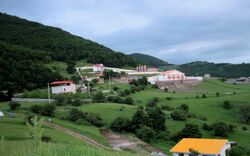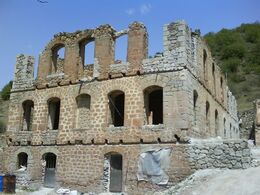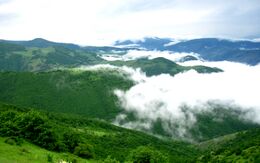مقاطعة خداآفرین
مقاطعة خداآفرين
فارسية: شهرستان خداآفرین | |
|---|---|
 طفرة البناء في القرى المهجورة سابقاً. | |
 موقع مقاطعة خداآفرين في محافظة أذربيجان الشرقية(أعلى الخريطة، بالأصفر) | |
 موقع محافظة أذربيجان الشرقية في إيران. | |
| الإحداثيات: 39°05′N 46°56′E / 39.083°N 46.933°E[1] | |
| البلد | |
| المحافظة | أذربيجان الشرقية |
| العاصمة | خمارلو |
| المراكز | الأوسط، گرمادوز، منجوان |
| التعداد (2016)[2] | |
| • الإجمالي | 32٫995 |
| منطقة التوقيت | UTC+3:30 (ت.إ.) |
مقاطعة خداآفرين (فارسية: شهرستان خداآفرین، إنگليزية: Khoda Afarin County)، هي إحدى مقاطعات محافظة أذربيجان الشرقية، إيران. عاصمتها مدينة خرمالو.[3]
بعد تعداد عام 2006، فُصلت منطقة خداآفرين عن منطقة کلیبر لتأسيس مقاطعة خداآفرين، والتي تم تقسيمها إلى ثلاث مراكز وسبعة مراكز ريفية، وعاصمتها ومدينتها الوحيدة خمارلو.[3]
في تعداد 2011 التالي، كان عدد سكان المقاطعة 34.977 سمة في 9.169 أسرة.[4] في تعداد 2016، بلغ عدد سكان المقاطعة 32.995 نسمة في 10.196 أسرة.[2]
قبل الثورة الإسلامية، كانت خمارلو مجرد قرية تتميز عن غيرها من القرى بوجود مقر قيادة الدرك الامبراطوري. يقع مكتب كاتب العدل في قرية عباس أباد ويديره رجل دين، والذي كان أيضًا بمثابة السلطة الروحية للمنطقة بأكملها.
. . . . . . . . . . . . . . . . . . . . . . . . . . . . . . . . . . . . . . . . . . . . . . . . . . . . . . . . . . . . . . . . . . . . . . . . . . . . . . . . . . . . . . . . . . . . . . . . . . . . . . . . . . . . . . . . . . . . . . . . . . . . . . . . . . . . . . . . . . . . . . . . . . . . . . . . . . . . . . . . . . . . . . . .
الاقتصاد
Before the Islamic Revolution of 1978, then a district of Ahar County, had a dynamic economy; the surplus agricultural products from fertile farmlands along Aras were exported to Ahar, and on the lush uplands large herds of sheep were a common sight. Of course, since the turbulent days of Azerbaijan Democratic Government, some residents were travelling to Tehran or Tabriz for seasonal work on construction projects, and by the late 1970s some of these migrant workers were established contractors. Accordingly, majority of active male population was spending half of the year in cities. The Islamic Revolution drastically changed social order. In the 1978–1979 period many of the migrant workers in Tehran constructed illegal dwellings on government lands at the North-East of Tehran and moved their families to the city. During the second big migration wave of the 1990s, most villages of the county were evacuated and residents settled in the shanty-towns at the South-West of Tehran. In recent years, some expatriates have returned and constructed decent houses. The county is already experiencing a construction boom. This has rapidly increased demand for construction workers. Moreover, the capital inflow to the county in anticipation of potential boom in Eco-tourism has resulted in launching many projects related to hotels and campgrounds.
اللغات
The spoken language of a vast majority of the inhabitants is modern Azeri Turkish, which has much similarity to Turkmeni, Afshar and the Anatolian Turkish[5]
The ancient Indo-European, Iranic language of the province before its turkification, survives in the Tati language, particularly in its Karingani dialect. In addition to the large village of Karingan, the villages of Chay Kandi, Kalasor, Khoynarood, and Arazin also are the last speakers of the old native language of Azerbaijan. .[6][7]
The mountainous terrain, shepherding and cultivation of hillsides possess the isolating features for the development of a sophisticated whistled language.[8] The inhabitants of the region employ the fingered whistle format for long range communication. More importantly, the majority of males are able, and perhaps addicted, to masterfully mimic the melodic sounds of musical instruments using fingerless whistle. Melodic whistling, indeed, appears to be a private version of the Ashug music for personal satisfaction.
التقسيمات الادارية
The population history and structural changes of Khoda Afarin County's administrative divisions over two consecutive censuses are shown in the following table. The latest census shows three districts, seven rural districts, and one city.[2]
| Administrative Divisions | 2011[4] | 2016[2] |
|---|---|---|
| Central District | 9,489 | 8,531 |
| Bastamlu RD | 5,407 | 4,561 |
| Keyvan RD | 2,423 | 2,068 |
| Khomarlu (city) | 1,659 | 1,902 |
| Garamduz District | 12,964 | 12,544 |
| Garamduz-e Gharbi RD | 8,826 | 8,308 |
| Garamduz-e Sharqi RD | 4,138 | 4,236 |
| Minjavan District | 12,524 | 11,920 |
| Dizmar-e Sharqi RD | 3,097 | 2,760 |
| Minjavan-e Gharbi RD | 4,214 | 4,094 |
| Minjavan-e Sharqi RD | 5,213 | 5,066 |
| Total | 34,977 | 32,995 |
| RD = Rural District | ||
المواقع التاريخية

- Vinaq. An old mansion in Vinaq village, which was built by Tomanies in 1907. The mansion is similar to the Aynaloo mansion in architecture.
- Baba Seyfaddin pilgrimage site near Garmanab village. The village is also a significantly important place as in last 150 years it has been inhabited by Armenians, followers of Yarsan religion and Shia Islam, respectively. The graveyard of Armenians has been preserved and the writings on the grave stones may provide important clues to the history of Arasbaran.[9]
- Khoda Afarin bridges. Two bridges on Aras river are located near Khomarlu. One bridge is badly damaged and the other is still usable for pedestrians. The later bridge is 160 m in length.
- Alherd village. This historical village has an ancient graveyard with tombstones, unusually, engraved with ornamental figures. It is possible that archaeological studies may unravel significant historical evidences.
موسيقى عاشيق
The county has been known as the epicenter of Arasbaran school of Ashugh music. The mountainous terrain, and the socio-cultural upheavals of the past two centuries have given a characteristic melancholic feature to the songs composed by the rebel-poets originating from the region. A revealing example is a song which was composed by Bahman Zamani following the tragic drowning of Samad Behrangi in Aras.
If, the mighty mountains can boast their height again,
If the crystal-clear water can irrigate the slopes again,
If, again, the ripen fruits can bent green branches,
Then, who says that my melodic words will not outlive me?
Two living masters of Ashugh music, Changiz Mehdipour and Rasool Qorbani, were born in Khoda Afarin county. In addition, many inhabitants, particularly the second generation immigrants living in Tehran, play Kopuz as a manifestation of their long denied cultural identity.
المصادر
- ^ OpenStreetMap contributors (3 April 2023). "Khoda Afarin County" (Map). OpenStreetMap. Retrieved 3 April 2023.
- ^ أ ب ت ث "Census of the Islamic Republic of Iran, 1395 (2016)". AMAR (in الفارسية). The Statistical Center of Iran. p. 03. Archived from the original (Excel) on 13 November 2020. Retrieved 19 December 2022.
- ^ أ ب Rahimi, Mohammad Reza (7 September 1389). "Letter of approval regarding country divisions in Kaleybar County". Laws and Regulations Portal of the Islamic Republic of Iran (in الفارسية). Ministry of Interior, Council of Ministers. Archived from the original on 26 September 2022. Retrieved 20 November 2023.
- ^ أ ب "Census of the Islamic Republic of Iran, 1390 (2011)". Syracuse University (in الفارسية). The Statistical Center of Iran. p. 03. Archived from the original (Excel) on 16 January 2023. Retrieved 19 December 2022.
- ^ Concise Encyclopedia of Languages of the World, 2010, Elsevier, p. 110-113
- ^ James Stuart Olson, Lee Brigance Pappas, Nicholas Charles Pappas (Editors), An Ethnohistorical Dictionary of the Russian and Soviet Empires 1994, p. 623
- ^ E. Yarshater, Iranian Languages and Texts from Iran and Turan, edited by Maria Macuch, Mauro Maggi, Werner Sundermann, 2007, page 443.
- ^ J.Meyer, Bioacoustics of human whistled languages: an alternative approach to the cognitive processes of language, Anais da Academia Brasileira de Ciências,76, 405-412, (2004)
- ^ "Panoramio is no longer available".
- Pages using gadget WikiMiniAtlas
- CS1 الفارسية-language sources (fa)
- Short description with empty Wikidata description
- Articles with hatnote templates targeting a nonexistent page
- Articles containing فارسية-language text
- Coordinates not on Wikidata
- Articles containing إنگليزية-language text
- Pages using Lang-xx templates
- مقاطعة خداآفرين
- مقاطعات محافظة أذربيجان الشرقية

